Scientific name Osmanthus Rank Genus | ||
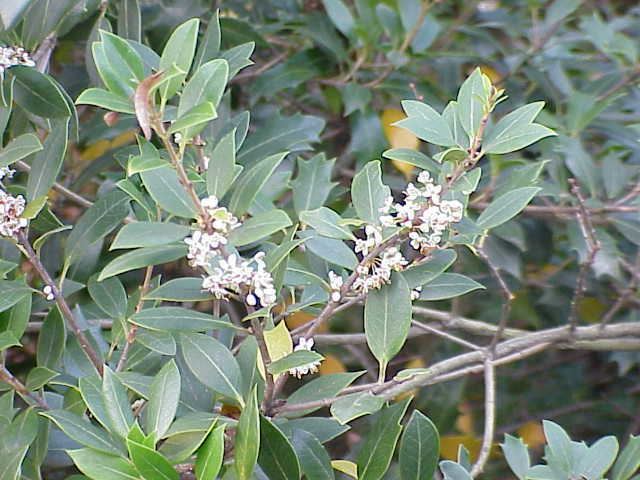 | ||
Lower classifications Osmanthus heterophyllus, Osmanthus fragrans var aura, Burkwood osmanthus, Osmanthus delavayi, Osmanthus americanus | ||
How to grow fragrant tea olive osmanthus fragrans with a detailed description
Osmanthus /ɒzˈmænθəs/ is a genus of about 30 species of flowering plants in the family Oleaceae. Most of the species are native to eastern Asia (China, Japan, Indochina, the Himalayas, etc.) with a few species from the Caucasus, New Caledonia, Sumatra, and North America (Mexico, Central America, southeastern United States).
Contents
- How to grow fragrant tea olive osmanthus fragrans with a detailed description
- Osmanthus in my garden
- Species
- Cultivation
- Uses
- References
Osmanthus range in size from shrubs to small trees, 2–12 m (7–39 ft) tall. The leaves are opposite, evergreen, and simple, with an entire, serrated or coarsely toothed margin. The flowers are produced in spring, summer or autumn, each flower being about 1 cm long, white, with a four-lobed tubular-based corolla ('petals'). The flowers grow in small panicles, and in several species have a strong fragrance. The fruit is a small (10–15 mm), hard-skinned dark blue to purple drupe containing a single seed.
Osmanthus in my garden
Species
Species accepted:
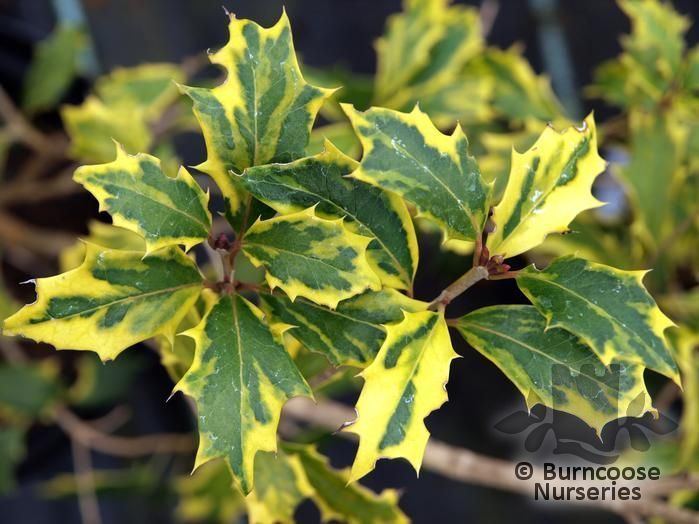
- Osmanthus americanus (L.) A.Gray - Devilwood - southeastern US from Texas to Virginia; eastern and southern Mexico
- Osmanthus armatus Diels - Shaanxi, Sichuan, Hubei, Hunan
- Osmanthus attenuatus P.S.Green - Guangxi, Guizhou, Yunnan
- Osmanthus austrocaledonicus (Vieill.) Knobl. - New Caledonia
- Osmanthus cooperi Hemsl. - Anhui, Fujian, Jiangsu, Jiangxi, Zhejiang
- Osmanthus cymosus (Guillaumin) P.S.Green - New Caledonia
- Osmanthus decorus (Boiss. & Balansa) Kasapligil - Caucasian Osmanthus - Turkey, Caucasus
- Osmanthus delavayi Franch. - Guizhou, Sichuan, Yunnan
- Osmanthus didymopetalus P.S.Green - Guangdong, Hainan
- Osmanthus enervius Masam. & T.Mori - Taiwan, Nansei-shoto
- Osmanthus fordii Hemsl. - Guangdong, Guangxi
- Osmanthus fragrans Lour. - Sweet Osmanthus, Sweet Olive, Fragrant Tea Olive - Himalayas (northern and eastern India, Nepal, Bhutan, Assam), Indochina (Myanmar, Thailand, Cambodia, Vietnam), Japan, China (Guizhou, Sichuan, Yunnan, Taiwan, Sichuan)
- Osmanthus gracilinervis L.C.Chia ex R.L.Lu - Guangdong, Guangxi, Hunan, Jiangxi, Zhejiang
- Osmanthus hainanensis P.S.Green - Hainan
- Osmanthus henryi P.S.Green - Guizhou, Hunan, Yunnan
- Osmanthus heterophyllus (G.Don) P.S.Green - Holly Osmanthus, Holly Olive, False Holly, Hiiragi - Japan, Taiwan, Nansei-shoto
- Osmanthus insularis Koidz. - Korea, Japan, Nansei-shoto, Ogasawara-shoto,
- Osmanthus iriomotensis T.Yamaz - Nansei-shoto
- Osmanthus kaoi (T.S.Liu & J.C.Liao) S.Y.Lu - Taiwan
- Osmanthus lanceolatus Hayata - Taiwan
- Osmanthus marginatus (Champ. ex Benth.) Hemsl. - Nansei-shoto, Taiwan, Vietnam, Anhui, Fujian, Guangdong, Guangxi, Guizhou, Hainan, Hunan, Jiangxi, Sichuan, Yunnan, Zhejiang
- Osmanthus matsumuranus Hayata - Assam, Thailand, Laos, Cambodia, Vietnam, Anhui, Guangdong, Guangxi, Guizhou, Jiangxi, Taiwan, Yunnan, Zhejiang
- Osmanthus mexicanus Lundell - Oaxaca, Chiapas, El Salvador, Honduras
- Osmanthus minor P.S.Green - Fujian, Guangdong, Guangxi, Jiangxi, Zhejiang
- Osmanthus monticola (Schltr.) Knobl. - New Caledonia
- Osmanthus pubipedicellatus L.C.Chia ex H.T.Chang - Guangdong
- Osmanthus reticulatus P.S.Green - Guangdong, Guangxi, Guizhou, Hunan, Sichuan
- Osmanthus rigidus Nakai - Kyushu
- Osmanthus scortechinii King & Gamble - Thailand, Sumatra, Pen Malaysia
- Osmanthus serrulatus Rehder in C.S.Sargent - Sichuan
- Osmanthus suavis King ex C.B.Clarke in J.D.Hooker - Assam, Bhutan, Nepal, Sikkim, Myanmar, Yunnan, Tibet
- Osmanthus sumatranus P.S.Green - Sumatra
- Osmanthus urceolatus P.S.Green - Sichuan, Hubei
- Osmanthus venosus Pamp. - Hubei
- Osmanthus yunnanensis (Franch.) P.S.Green - Yunnan, Tibet
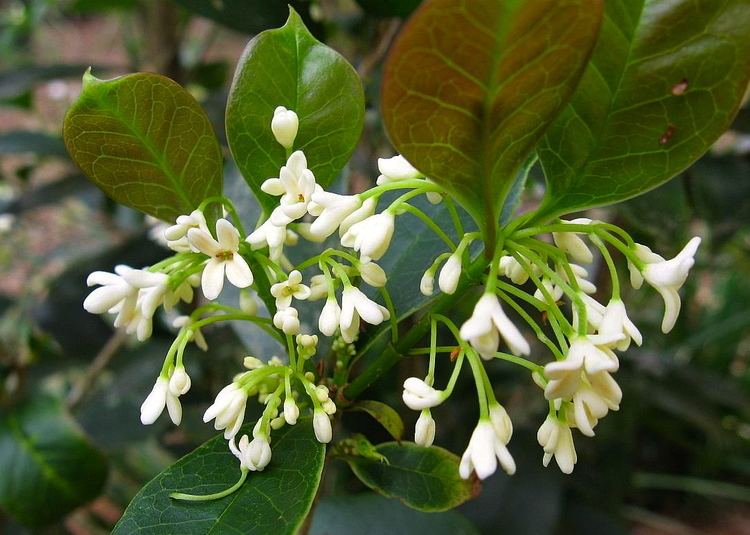
Cultivation
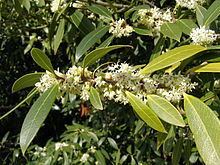
Osmanthus are popular shrubs in parks and gardens throughout the warm temperate zone. Several hybrids and cultivars have been developed. Osmanthus flower on old wood and produce more flowers if unpruned. A pruned shrub often produces few or no flowers for one to five or more years, before the new growth matures sufficiently to start flowering.
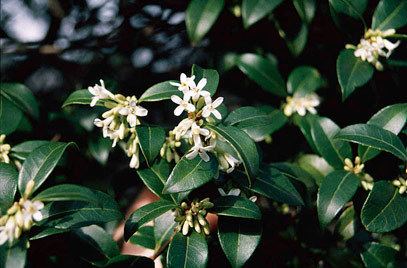
In Japan, sweet osmanthus (gin-mokusei) is a favorite garden shrub. Its small white flowers appear in short-stalked clusters in late autumn. It has an intense sweet fragrance. A variant with deep golden flowers (kin-mokusei) is also popular.
Uses
The flowers of O. fragrans are used throughout East Asia for their scent and flavour, which is likened to apricot and peach.
In China, osmanthus tea (桂花茶, guìhuāchá) combines sweet osmanthus flowers with black or green tea leaves. Traditional Chinese medicine claims that osmanthus tea improves complexion and helps rid the body of excess nitric oxide, a compound linked to the formation of cancer, diabetes, and renal disease.
Osmanthus wine flavours huangjiu or other rice wines with full osmanthus blossoms and is traditionally consumed during the Mid-Autumn Festival.
